
Taking a short cat nap in the middle of the kitchen in the middle of a college cast party. I appear to be dressed as a flapper and I am not sure why because it wasn’t a costume party.

Taking a short cat nap in the middle of the kitchen in the middle of a college cast party. I appear to be dressed as a flapper and I am not sure why because it wasn’t a costume party.

“We didn’t know what we were doing at all. And it’s cool to be a rudimentary example of something that somehow does something – is able to do a few shows and make records. It’s a miracle. It’s like dogs dancing: it’s not that great but it’s amazing that it happens at all.” — Evan Dando, Forbes interview, June 2022
It’s his birthday today.
I was never a huge Lemonheads fan, although I appreciated them. Not to be cliched, but Evan Dando was so … gorgeous, it was just an unavoidable fact, and so there was a lot of attention put on his looks. (Kurt Cobain was gorgeous too and I don’t remember the same kind of objectification going on. Like, not every article started off with how handsome he was.) Evan Dando seemed so disinterested in that whole entire conversation – in his looks, in general. There’s no way he could have been unaware of his handsomeness, or maybe he resented it? I don’t know, he was just totally casual and “over” looking like he did, which was a fucking movie star. He had a small role in James Mangold’s first film, Heavy, starring Liv Tyler, with Pruitt Taylor Vince and Debbie Harry – !! – and Shelley Winters – !!! There really weren’t any other characters. I saw Heavy at the Angelika theatre when it first came out, and was captivated by the tiny story. I can see its flaws now – the common “tropes” at play – but I honor my first impression as coming from an authentic place. Evan Dando plays the carelessly cruel entitled and deadpan boyfriend of Liv Tyler, brooding gorgeously in the background, not being all that nice to her. While it’s not a huge role, he’s crucial to the plot. I went into the film cold, so i remember thinking, “Wait a second … is that Evan Dando??”
My commentary is pretty surface-level, so I want to point you to my brother’s essay on the Lemonheads, his own journey with Evan Dando, and his observations Dando’s songwriting. (I think it’s pretty telling – and cool – that Dando loves – and I mean loves – the song “Frank Mills” from Hair. “Frank Mills” showed him the possibilities of songs as storytelling. I love that.)
Thank you so much for stopping by. If you like what I do, and if you feel inclined to support my work, here’s a link to my Venmo account. And I’ve launched a Substack, Sheila Variations 2.0, if you’d like to subscribe.
The Golden Bachelor
Watched – in great hilarity – with Karen and Allison during a raucous sleepover, and Carol pulled up on FaceTime. So we could watch together. The whole thing is so ridiculous.
Maestro (2023; d. Bradley Cooper)
I didn’t know much about Leonard Bernstein except 1. his music and 2. Tom Wolfe’s ruthless “Radical Chic”. Once you read “Radical Chic”, you cannot un-read it. Naturally, it is not covered in Maestro. Had a great time going to see this in New York with Mitchell, Allison and Eric at the Paris Theatre. There was a line down the block. The joint was PACKED. I was disappointed by the film in some aspects – the usual biopic reasons: there wasn’t enough focus on the work and how he worked. But I also loved it in other aspects. Biopic tropes are like a centrifugal force. But still, it’s impressive and clearly a passion project for Cooper. That really reads.

Uppercase Print (2020; d. Radu Jude)
Radu Jude is one of the most exciting filmmakers working today. I hadn’t seen this one and it was streaming on Criterion so I checked it out. It’s 3 hours long, an adaptation of a stage play, taken entirely from secret police transcripts and documents during an investigation into the identity of the person covering walls with graffiti slogans like “Freedom and Liberty”. The lengths the secret police went to – bugging apartments, constant surveillance – is psychotic. The “culprit” was just a kid sick of living in a dictatorship. The kid was inspired by the Solidarity movement in Poland. He was not alone. He wanted the same kind of movement in Romania. The kid was treated like an enemy of the people. His life was ruined. His family’s life was ruined. When people express concerns about “cancel culture”, sometimes it’s because they know how it can actually play out in real life when wielded by the State. Radu Jude filmed this like a play – perhaps reflecting the original production? I don’t know. – where people step out of the shadows to tell their side of the story. Every single word spoken is from the massive police files. Imagine the resources devoted to this, the vast architecture of bureaucrats necessary to investigate graffiti. Imagine a government that scared not just of freedom of expression but freedom of thought.

The Taste of Things (2023; d. Tran Anh Hung)
I adored this film, mouth-watering food, beautiful understated performances, a mood of tenderness and care. It was very moving. I reviewed for Ebert.

Memory (2023; d. Michel Franco)
I had the great pleasure of interviewing Peter Sarsgaard onstage at the Jacob Burns Film Center, after a screening of this beautiful new film about a man suffering from early-onset Alzheimer’s. Co-starring Jessica Chastain, Memory is extremely poignant, without sentimentality. It’s not designed to tug at your heart strings. Franco’s style is unobtrusive in a way: he films without too much interference in the visual imagery, not a lot of cuts or closeups. Scenes play out in one. This gives his work a sense of “this is really happening right now”. It was great to get to talk to Sarsgaard – to a packed house! Great crowd! Finally got to meet long-time “regular” here, Todd, whose comments have always been so amazing, and we’ve also corresponded quite a bit. It was so great!
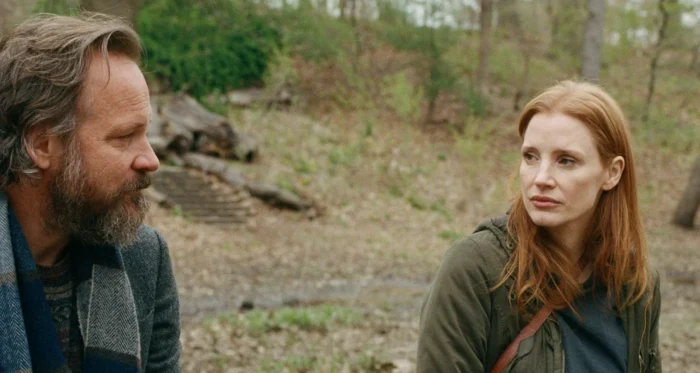
All of Us Strangers (2023; d. Andrew Haigh)
I was wrecked by this one, so much so that I wasn’t sure how to approach my review. I didn’t even know what to say. I don’t think this has happened in my entire time reviewing stuff for Ebert. I really had to pull my shit together, and at some point I had to just admit I failed. Here’s my review.

Stranger Things (2017)
Still working through Season 2 with my niece. I haven’t had as much time as I would like to do some real binge-watching. Now that I’m settled into my new place, I think I need to institute some sleep-over binge-watch parties. I think the show is amazing. My niece gave me an “Eleven” cup for Christmas. It’s hilarious.

Wings of Desire (1987; d. Wim Wenders)
A masterpiece.

Beyond Utopia (2023; d. Madeleine Gavin)
This and 20 Days in Mariupol were the top docs of 2023. Both show unbelievable footage, footage dangerous and life-threatening to those participating in it, footage important to show the world, footage worth risking your life for. Getting people out of North Korea is not just daunting, it seems almost impossible. The smuggled footage in North Korea itself is haunting and dystopian. The pain is beyond imagining. The network of smugglers and spies and drivers and safe houses required to get people from China down into Thailand, a “safe” country, is a whole cottage industry (and ripe for exploitation by bad actors). You watch this one small family, and what they go through after crossing the river into China – the arduous journey – through mountains and jungles – evading capture … I mean, the fact they are willing to put themselves through all that tells you all need to know about the conditions in North Korea. I have nothing but admiration for the people who have devoted their lives to helping people get the fuck OUT of that concentration camp of a nation.

Paterno (2018; d. Barry Levinson)
A reminder, as if we needed one, of Al Pacino’s stature as an actor. It’s a great late performance. He was great as Hoffa too in The Irishman, but Hoffa was in his wheelhouse: big talker, charismatic, loud, blustering, etc. Pacino could play Hoffa in his sleep. But Paterno? A repressed retiring obsessive passive guy afraid of conflict, except on the football field? None of this is in his wheelhouse. A guy who never throws a temper tantrum? Who never lets off steam? The amount of restraint Pacino had to wield as an actor, to avoid his usual tricks, to nOT allow himself any crowd-pleasing Al-pleasing catharsis … THAT is why he is a great actor. It was so great to see Kathy Baker too: they have one scene together close to the end that made the hair on the back of my neck stand up. You have to be a hell of a good actor to pull off that scene because on the surface they are saying one thing, but underneath, she is saying everything. And he is caught, struck, trapped, by the implications of what she is saying. He understands that he does not understand at all what has happened. It’s like he breaks, finally. But you can barely SEE the break, because this man is so repressed. It’s such a great acting lesson, this performance, and should be studied as closely as his performance as Michael Corleone.

Happy Valley (2014; d. Amir Bar-Lev)
A follow-up to Paterno. The story is so infuriating I needed to take a shower after watching these two things back to back.

Society of the Snow (2023; d. J. A. Bayona)
An extremely effective telling of the crash in the Andes, with a Urugyan and Argentinian cast – many of whom have no acting credits (or very few). The arduous nature of the shoot is apparent in every frame: it’s impossible to tell how they even GOT some of the footage. All kinds of psychological and philosophical questions are impicit in this story: there’s a reason we keep coming back to it. Roberto and Nando are awe-inspiring figures: they had the mental toughness to set out for Chile across the Andes – starving and dehydrated – with no mountaineering gear, or mountain-climbing experience. But it was that or death. Brave brave boys. I reviewed for Ebert.

The Settlers (2023; d. Felipe Gálvez Haberle)
An incredible directorial debut. In it, he grapples with Chile’s brutal past of colonialism and genocidal violence. I reviewed for Ebert.

You Hurt My Feelings (2023; d. Nicole Holofcener)
I had somehow missed this one in the rush of last year, despite loving Holofcener’s films, and loving Julia Louis-Dreyfuss (their collab Enough Said is to be treasured on its own, even without the poignant fact that Jim Gandolfini gives a performance revelatory in ways none of his other performances are. Holofcener was the one who gave him that chance. So good.) :I really love the premise of You Hurt My Feelings. A wife overhears her husband talking to a mutual friend about the book she’s just written. She’s insecure about it already and he’s been supporting her through the writing process. Unfortunately, she hears her husband say the book is not good and he doesn’t know what to tell her. Her whole world shatters. Her marriage teeters on the brink. It’s a total CRISIS. Maybe she’s over-reacting? Sure. But … life is made up of these ruptures, and we don’t always approach everything with the proper amount of perspective, especially if you’re a writer or an artist. She feels betrayed and embarrassed, and Louis-Dreyfuss does not hold back. She’s literally cringing with agony and shame every time she thinks about what he said, and his “betrayal” of her. Great cast. Loved it.

Close Your Eyes (2023; d. Víctor Erice)
I watched this in preparation for the National Society of Film Critics vote, since one of our categories is for films awaiting U.S. distribution. This was one of the titles floated about. It’s been 30 years since Erice directed a feature film. The man is 82 years old. He’s only directed four films. After watching Close Your Eyes, I would put it at the top of my list of 2023 films, PERIOD, even though it’s only been shown at festivals (so far). Close Your Eyes is an investigation into a disappeared man, but it’s also about ghosts and memories, about about the impermanence of life (and art). It’s about filmmaking, about directing. It’s innovative cinematically and deeply sad. You can’t make a movie this melancholic without having lived a long long life. The sadness is about goodbyes: the finality of them. And yet the film is not dreary or glum. It’s alive and rich and vivid. Leonardo Goi wrote about it for MUBI.
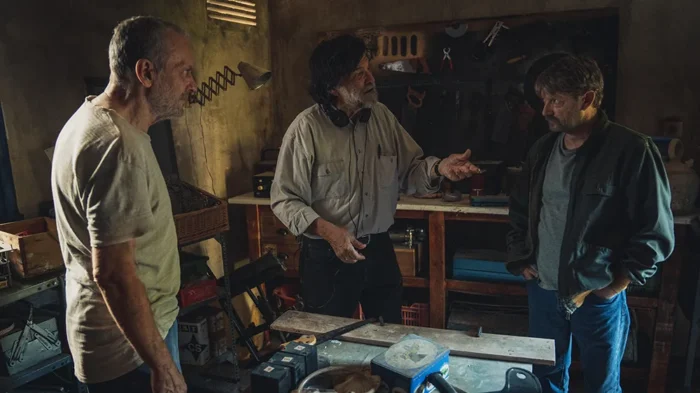
Safe in Hell (1931; d. William A. Wellman)
I’m not sure how I had never seen this one before. I love William Wellman’s films. It’s a crazy mix of Pre-Code gangster and Tennessee Williams Camino-Real gin-soaked end of the road. With a wild ending of martyrdom and self-sacrifice. I am not familiar with Dorothy Mackaill’s work, she was new to me, so that’s always fun. As with all Pre-Codes, this story is told without coyness or euphemism. The lead character was basically abandoned into a life of prostitution – she had no choice – and when she flees to some tropic island to escape, the sense of sexual threat is palpable. She won’t be able to hold off all those men for long. It’s ugly. The ending isn’t really Pre-Code, it’s more Victorian melodrama, making Safe in Hell a strange brew. I dug it.

Sometimes I Think About Dying (2024; d. Rachel Lambert)
A quiet strange little movie. I liked the parts of it more than the whole. Worth checking out though. I reviewed for Ebert.

The Servant (1964; d. Joseph Losey)
A masterpiece. Chilling. Dirk Bogarde at his chilly destabilizing very best. James Fox as the posh prick who descends into … filth, really, and madness. The women, Sarah Miles, Wendy Craig – polar opposites – both fascinating, alluring, scary. A Chabrol-esque La Ceremonie feeling of dread. And the way it ends …. This film is as brutal about class – maybe even more so – than Parasite. The two films have a lot in common.

Threads (1984; d. Mick Jackson)
A nuclear winter BBC television event. I wrote about this – and two other television dramas from 1983-4 – on my Substack.

American Nightmare (2024)
I had somehow missed this story. I don’t know how! It is truly terrible. And terrifying. You can still feel the trauma in those interviewed.

The Passaic Textile Strike (1926; d. Samuel Russak)
A very important and groundbreaking film which I had never seen in its entirety before (although much of the footage was familiar). The film was produced by the Workers Communist Party and the International Workers Aid organization to raise awareness about the textile workers’ strike in Passaic, which started at one plant, and then spread to other plants. The clashes with police were violent. All of this was caught on camera. In 1926, you got your news primarily from newspapers, which is great, but there’s nothing like actually SEEING something unfold in motion, seeing what it looked like, actual people. The textile workers were on strike for a year. It was a standoff. The film starts with a fictional narrative, to draw us into the strike itself, give it a personal feel. Stefan, a Polish immigrant, works in the textile mill, saving enough to bring over his wife. She arrives, hopeful to be there in the land of plenty, away from the pogroms and oppression in Poland. To her dismay, though, she finds nothing but slums and poverty, poor working conditions, failing health. They have children, but eventually things are so tough their 14-year-old daughter drops out of school and starts working at the mill (where she is groomed and then raped and then fired by the big boss man. The film does not pull its punches.) Nothing improves and Stefan’s health fails. He dies, leaving his family unprotected, with no way to put bread on the table. This is the prologue. The implicit message is: “This is just one story of many.” The rest of the film is documentary footage of the strike. It’s incredible. The whole thing’s on YouTube.

The Song of the Shirt (1908; d. D.W. Griffith)
A short film by Griffith about the trials and tribulations of women who work in a shirt factory. Eerily, the film pre-dates the Triangle Shirtwaist Factory fire in 1911 – a tragedy which galvanized the entire labor movement in America. (I am assuming the title of the film is taken from the famous Thomas Hood poem, about a broken-down seamstress.) Griffith was a virulent racist, but he also made tons of films sympathetic to the plight of the (white) poor. One doesn’t cancel out the other, of course, but the racism needs to be acknowledged, not ignored. Compared to the prologue fictional scenes in Passaic Textile Strike, the poverty in Song of the Shirt looks genteel, but the film is still an attempt to highlight inhumane and unsafe working conditions for the women who toiled away in these shirtwaist factories.

Children Who Labor (1912; d. Ashley Miller)
Clearly there’s a theme here. This 1912 melodrama addresses the barbaric practice of hiring children to work in factories. Cheap labor. Children died. Easily. They suffered, were injured, died of malnutrition, exhaustion. This film shows a desperate family who have no choice but to send their child to work. (Factories stopped hiring men since children were cheaper.) The children are treated appallingly. The rich boss is seen at home, fat and complacent, as his adorable children run around the house, allowed to be kids. All that changes when the rich little girl gets separated from her family and is taken in – kindly – by the very same poor family, whose daughter has gone to work in the factory. A case of hidden identities. So now the little rich girl is going to work in her dad’s factory. Will the mistake be eventually righted? Will the little girl be returned to her parents? Will the evil industrialist have a change of heart once he sees how it’s affected HIS child? Listen, it’s a melodrama, but it has a very serious purpose.

Labor’s Reward (1925; produced by the American Federation of Labor)
There’s this whole world of labor-focused films, produced by labor organizations … and so clearly I have been dipping my toes into this rich archive. Many of these films are lost, damaged beyond repair, like the majority of all silent films … but some have survived. Only one reel of this one has survived, and it’s on YouTube. It gives a good feel for it: the factory scenes look and feel real. Location shooting. Not a cleaned-up set like Griffith’s. The downtrodden workers, facing poverty, injury, no workers’ comp, start to murmur amongst themselves about perhaps unionizing.

The Day After (1983; d. Nicholas Meyer)
I wrote about this nightmarish generational-trauma-bonding television event on my Substack.

Special Bulletin (1983; d. Edward Zwick)
See above. This is way scarier than Day After, although not scarier than Threads. Also wrote about on my Substack.
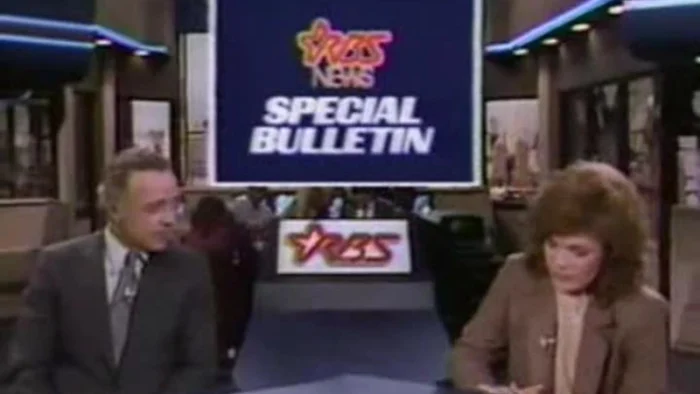
The War Game (1966; d. Peter Watkins)
Also wrote about in the Substack piece. A pre-cursor to the 1983-4 juggernaut. A pseudo-documentary. No professional actors. Incredibly effective.

Testament (1983; d. Lynne Littman)
I didn’t see this in 1983, but I remember reading Roger Ebert’s review (my parents kept collections of his reviews around: it was my film school). 1983 was also the year of The Day After and Special Bulletin. This gives you an idea of how RATTLED the world was with the ratcheted-up war rhetoric flying back and forth between Moscow and Washington. Testament is so powerful, so quietly devastating, even without ever showing the blast. We just see the aftermath. And it’s quiet, and relentless. The unthinkable becomes normal. This normal family with its normal problems have to adjust to something beyond comprehension. Lynne Littman didn’t direct all that much before or after Testament – some television here and there – but Testament was nominated for a Best Picture Oscar (and was nominated/won all kinds of other awards). The film has a haunting staying power.

Panic in Year Zero (1962; d. Ray Milland)
If 1983 was jittery, then 1962 was even more so. The Cuban Missile Crisis, for one. Panic in Year Zero was directed by actor Ray Milland, who also stars. It was distributed by Roger Corman’s American International Pictures, as a sci-fi movie (heh). A nice suburban family, mom, dad, and two teenage kids, get into the car and drive into the mountains outside Los Angeles to go camping. They have a little camper van, this is the thing they regularly do as a family. While driving through the mountains, they lose the radio, and suddenly they notice all kinds of strange activity on the curvy mountain road: cars zooming in the other direction. They pull over, get out, look behind them in the general direction of Los Angeles, and see a massive mushroom cloud rising. The gender roles in this movie are crazy. Dad immediately goes Alpha male, ordering his family around, hunkering down in commando fashion, assuming all of civilization is going to break down, and it will be every man for himself. He buys basically an arsenal of guns. He ignores his wife’s pleading to calm the hell down. He basically goes vigilante. It’s so tiresome. The only place civilization is breaking down, bub, is in your own car, because you are being such a bully! Jean Hagen plays the mom, and Frankie Avalon (!) and Mary Mitchel play the teenage kids. The family eventually hides out in a cave in the camping ground, and there are juvenile delinquents on the loose and … etc. So the nuclear bomb that went off just over there is … secondary to doing battle with the crazy kids out on a joyride. It’s bizarre! Meanwhile, there’s this weird sort of propaganda about gender roles, and conceding to how dad wants to do things, even though Dad is clearly Michael-Douglas-in-Falling-Down losing it.

True Detective, Season 1, 3, 4
I’m the last to the party. As clicked in to what’s going on as I am, I have a talent for avoiding buzz. I am AWARE of the things I missed, but beyond the title, I don’t know much. I was years late to Mad Men, for example. There were years where I didn’t even have a television. My television was basically used for movies, on physical media. I know this is hard to comprehend but … my movie-watching is so intense and, you might even say, extreme … I was fine with NOT being up-to-date on TV shows. I am actually used to not having television in my life. Of getting to things on my own timeline. Which is more and more possible in the streaming era. But there are plenty of ground-breaking shows I just never participated in. I finally caught up with Breaking Bad, but after it stopped airing. And don’t even get me started on X-Files. I basically just missed it during its entire original airing (although, weirdly, Mulder and Skully had infiltrated my consciousness anyway). So. True Detective. I knew about it, and I also knew I would probably love it. I love all those people. McConaghey. Woody Harrelson. Mahershala Ali. I got inspired to check it out after being a guest on Ryan and David’s Adult Film podcast, and both of them mentioned loving it. As usually happens with these things, within about 20 minutes of the first episode, I knew I’d be clearing my schedule to binge the whole thing. Full disclosure: I skipped Season 2. With all the interest of the plots – and they were all extremely gripping – the real thing that stands out is the acting, and the space cleared in this series for well-known actors to give truly great performances, of a kind of depth and complexity not really present in the movies right now, sadly enough. Matthew McConaghey outdoes himself, far out-pacing his other work – by a long shot – and the final scene of Season 1 … he outdoes himself again. I was like, “Okay, that is some of the finest acting I’ve ever fucking seen.” Still blown away. And Mahershala Ali … my God: he has to play the same character at three separate points of the timeline: young, middle-aged, old. Even more fascinating, he was such a difficult man, prickly, tough to reach, not ingratiating … and yet you, the audience, adored him. The physical work is so good. The character work is exquisite. This is not amateur hour. You need great actors to pull all this off. And so the series is a master class for actors and acting. If you’re into the craft of acting, this series is a great teaching tool. I just finished Season 4, and I’m feeling similarly about Jodie Foster’s work. I think she has limits as an actress, and here, the limits serve her. And Kali Reis is fantastic, and these two make an amazing pair onscreen. They’re very similar as actors, even though Foster is a pro, and Reis is, comparatively, very green. (I reviewed the film Catch the Fair One, which was my introduction to her.) They both present as so tough, impenetrable really, formidable. And that’s all fine and good. It’s cool to see people who seem authentically tough. But … without vulnerability, that kind of acting can only go so far. You just get the attitude, you don’t get what’s motivating it, or what’s underneath it. When Kali Reis breaks down, you feel like the world is ending, because you can see how much it costs her, to be strong all the time. The same with Foster. I’d like to write more about this so I’ll save it for later. But I just loved watching these two together.

Lone Star (1996; d. John Sayles)
This gorgeous film has been out of circulation for decades. It was not streaming anywhere and if I’m not mistaken it never made it to DVD. Maybe it did? But I feel like if it had, I would have bought it. Because this film made such a huge impression on me when I first saw it – in the theatres – that I still remember scenes, images, shots, vividly. It’s like my experience with another “lost” (for a long time) film What Happened Was…. There are a lot of “lost’ films in the mid-90s when technology switched from VHS to DVD. a lot of current things did not make the cut. I was in grad school and I went to go see Lone Star up at the Lincoln Plaza Cinema (RIP). I saw so much great stuff there. Welcome to the Dollhouse. Burnt by the Sun. Jim Jarmusch’s Dead Man. Like I said: the mid-90s was a hell of a time to be a moviegoer! I was totally enraptured by Lone Star, its intricacies, the characters, the sense of a small town and fluid borders, the clear political message told with a humanist approach, the way things tied up in the end … but then was left ambiguous, ambivalent, the two lovers sitting on the hood of a car, staring up at an abandoned drive-in movie screen. Elizabeth Pena! Her best role! And it was the first time I encountered Chris Cooper. Matthew McConaghey too had just hit it HUGE, and there he was in a small role. I think I went to go see Lone Star by myself and I remember writing about it in my journal afterwards. Even back then I was keeping a movie diary, only it was all analog. Because I never saw it since then, it’s taken on kind of a mythological space in my head, similar to my feelings for What Happened Was… And so how exciting, what a thrill, when Criterion announced it would be releasing the film. I love it when they take on THESE types of films, major works lost or hidden for whatever reason, works needing restoration, a little love and care. Yes, it’s great to come out with a new version or a 4D version of an old classic … but something like Lone Star, long out of circulation, is different. Finally, it’s back with us. We get to be with it again, see it again. I really loved Domino Renee Perez’s booklet essay for the Criterion release. Sitting down to watch it again had this whole ceremonial aspect. I got myself positioned, I had my drink, my blanket around my knees, I cleared the deck, I turned my phone off. Listen. Lone Star is back with us. Attention must be paid.

The Promised Land (2024; d. Nikolaj Arcel)
This shares some similarities with The Settlers, although it’s not genocidal in nature. But it is about the “settling” of an inhospitable landscape, and the dogged determination of one man to create something out there on the heath. But at what cost? It’s based on a true story with some obvious fictionalizations, but I dug it. I reviewed for Ebert.
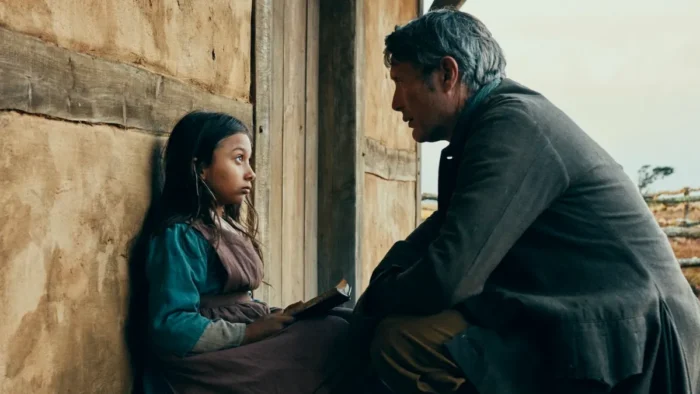
Orchids and Ermine (1927; d. Alfred Santell)
Colleen Moore stars as Pink, a flapper with dreams of being rich. She’s kind of a bore about it. She wants to wear orchids and ermine all day every day! Instead, she’s a switchboard operator at a posh hotel, watching oil millionaires and their ermine-stole-clad mistresses strolling by. Shenanigans ensue. This is the classic “common” girl pulled above her class by love. A millionaire falling in love with a peasant. But of course he’s in hiding, not letting anyone KNOW he’s a millionaire. And so Pink, too, is redeemed because she’s fallen in love with HIM and not his money. Moore is adorable, feisty, funny.

With Babies and Banners (1979; d. Lorraine Gray).
I tripped over this in my dig into films about American labor. The film was made possible by the Women’s Labor History Film Project, and profiles the Women’s Emergency Brigade during the huge GM sit-down strike in Flint, Michigan in 1936. The men holed themselves up in the factory, refusing to come out. The power was cut. The water shut off. Their wives at home, living completely traditional “housewife” lives, finally got together and decided to do something to help the strike. They organized supply chains, they made food (I mean, soup kitchens worth of food), they delivered the food to the windows of the factory – they faced harassment, jeers, all the rest. This documentary, made in 1979, features a reunion of the women who made up the brigade, all old women, to talk about this experience. What an incredible film. I was intensely moved by it. I highly recommend taking the time to watch:
Street Scene (1931; d. King Vidor)
Based on the award-winning play by Elmer Rice, this Pre-Code takes place mostly on the stoop of a single building in New York City, populated by lower-working-class immigrant families – Italians, Jews, Poles – and their struggles to survive. Not much has been done to the script: it still feels like a play, with people hanging out the windows to chat with people below, and people running in and out of the door. The struggles are all different, but all connected to the economic status of the people living in the neighborhood. Sylvia Sidney – that glorious actress, who worked all her life, but whose heyday was Pre-Code – plays a young woman living in the building, being “courted” by her rich co-worker who basically wants her as a “kept woman”. She, though, is in love with the dreamy Jewish boy, whose parents are constantly yelling at him from out of the window. A wonderful ensemble drama.


The Crowd (1928; d. King Vidor)
I’ve seen this masterpiece multiple times, the most memorable one being at the IFC Center in 2014, as part of my friend Farran’s book launch (her wonderful novel Missing Reels, which opens with an epigraph from the film’s intertitles.) Another memorable time was in 2022 when Farran, Charlie, and Ted went to go see it playing at the Walter Reader. A packed house. Going out into such a huge crowd was still a novelty then, and there was a giddy sense of celebration in the simple pleasure of meeting up for a movie and then going out for drinks. If you get a chance to see The Crowd in a theatre, please do so. It plays like gangbusters. And that final scene … There are so many good sequences but the final scene moves into surreality and becomes a blistering critique of all of modern life in its heartlessness and inhumanity. It’s breathtaking.

The Devil and Miss Jones (1941; d. Sam Wood)
Jean Arthur and Charles Coburn, paired up again after one of my favorite movies ever, The More the Merrier. In this one, Coburn plays the owner of a chain of department stores who goes undercover in the shoe department to discover the working conditions of his own employees (who appear to hate him, and actually burned him in effigy). Unionizers meet up in secret. Jean Arthur and the union leader are a couple, and they take this elderly man into their confidence. Hijinx ensue.

Blue Collar (1978; d. Paul Schrader)
I can’t even believe this movie exists, to be honest. It seems like it wouldn’t be allowed. It still feels radical.

Here (2024; d. Bas Devos)
What a beautiful quiet thoughtful movie. I keep thinking about it. I reviewed for Ebert.
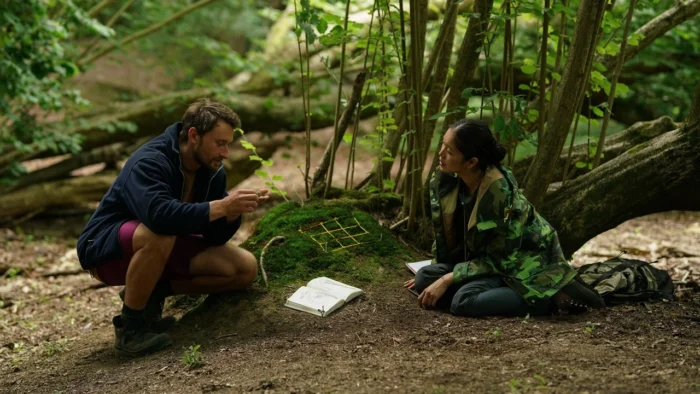
I Don’t Feel at Home in This World Anymore (2017; d. Macon Blair)
I remember watching this when it came out and adoring it. I really like Macon Blair (loved Blue Ruin), and this is his directorial debut. Melanie Lynskey stars as a kind of downtrodden nurse’s assistant who comes home one night to find she’s been robbed. Her grandmother’s silverware was stolen. She feels violated. The police won’t do anything. So she goes on a search for justice. She ropes in her crazy neighbor, an isolated weirdo played by Elijah Wood. This is a madcap caper, in a lot of ways – with some legitimately laugh-out-loud funny performances/moments – but even more impressive is the mood is sustained. And it’s a difficult mood to sustain. It’s not strictly a comedy. There’s a strain of anger, and also this overall sense of malaise/dissatisfaction (I mean, look at the title, after all). I had forgotten a lot of it – how it resolves itself – and it was fun to re-discover what the hell happened. Really love this film.
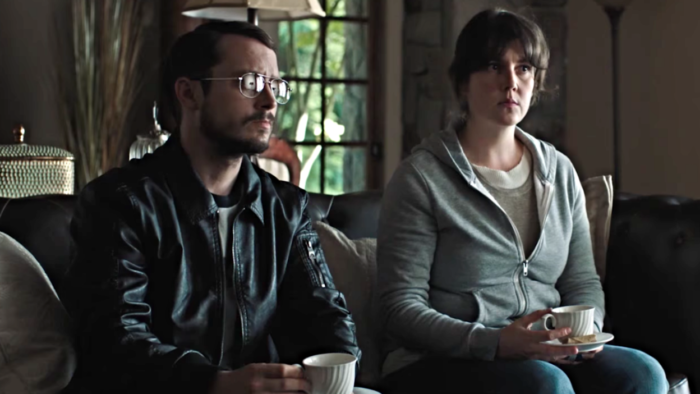
Players (2024; d. Trish Sie)
A throwback rom-com. The secondary characters make this film. I reviewed for Ebert.

Waking the Dead (2000; d. Keith Gordon)
God, this fucking film. I saw it in the theatre when it came out because my friend Ted told me about it. We have talked about it many times since. It’s haunting, weird, intense. I love it so much.

Child of the Ghetto (1910; d. D.W. Griffith)
Another Griffith short about the plight of the poor. Another Griffith short about the plight of seamstresses. Seamstresses had it bad.

Lily of the Tenements (1911; d. D.W. Griffith)
Newsflash from Griffith: Seamstresses are in Peril! Melodramatic, with some twists and turns, a seamstress struggles to keep up with her work, and her lecherous boss clearly has ideas in his head. Griffith is caught up in melodrama. There’s usually a deus ex machina. There’s a woman in danger, and a hero arrives at the very last moment. The End.

Work (1915; d. Charlie Chaplin)
Hilarious. When he falls through the open manhole cover, I freakin lose it. I love the mockery of the hoity-toity couple who hire him. They are clearly total trash. They abuse their maid – whom they don’t even need – there is a giant bear skin rug in their way too small foyer – and they seem completely shocked at these two dirty handymen who show up at their home and wreak havoc. Granted, if you hired a couple of guys to paint the walls and they completely wreck your house, you could be excused for being a little, how you say, upset.

Spotlight (2015; d. Tom McCarthy)
I reviewed for Ebert. I have some go-to films when I want to just chill. They’re often “procedurals”. They’re often newspaper movies. I love Shattered Glass (see below). I love The Post. I love Zodiac. It may seem weird that I would pop on Zodiac to “chill”. There’s a comfort in knowing the movie so well. And I know Spotlight really well. I think it’s excellent. So I watched it again.

From the Submerged (1912; d. Theodore Wharton)
Chicago locations, which is fun! This is a short film dealing with issues of hardship, suicide, class distinctions, privilege … it’s a lot for a short film! Basically there’s a rich guy who lives like a homeless guy, hating the privilege into which he was born, finding it soulless and alienating. He is about to throw himself off a bridge when he is saved by a caring woman who happens to be passing by. Even though he does go home to his rich family, and takes up with a rich cruel woman, he can’t forget the kindness of the woman who saved him.

A Raisin in the Sun (1961; d. Daniel Petrie)
Re-watched in honor of Sidney Poitier, who passed last month. He’s so MAGNETIC, but everyone is so good here. The film lives or dies on its ensemble work, an ensemble in this one cramped location. The script is airtight. It almost plays itself, it’s that good.

The Exit of the Trains (2020; d. Radu Jude)
See above comments in re: Radu Jude. I was avoiding this one because it is 3 hours long but I sat down to watch. It’s a tough one. But at a certain point, I realized what the film was doing was paying tribute to everyone who lost their lives in the pogrom of June 29, 1941: every story was identical, and hearing it over and over again over 3 hours was its own devastating critique. Jude uses an army of voiceover actors, reading the transcripts of survivors and family members, who had to watch their husbands, sons, dragged out of their homes and taken to the “police station”, where they were shot, or put onto “death trains” where they all suffocated. Horrifying.

Dublin Murders (2019)
Finally caught up with Dublin Murders – which I admit I avoided because I love Tana French’s books so much. I often come to things years late (see: True Detective, Mad Men). OR, I am WAY early. I am rarely on time. The TV adaptation is made up of the first two books in French’s Dublin Homicide squad series, In the Woods and The Likeness. I think The Likeness doesn’t fare as well here as In the Woods, mainly because the book works through the accumulation of details making up the intimate cult-like environment in that weird old house with those students. The series can’t accomplish this because they condense the timeline. But In the Woods fares beautifully. Granted, it’s not the same thing as reading the book, so don’t just watch the series and think you understand. lol
Sarah Greene is fantastic (I loved her as the mum in Normal People), and The Likeness allows her to really show her skill, playing the double role. But Killian Scott (who changed his name from Killian Murphy, for … obvious reasons) is such a standout. The character of Rob / Adam is so difficult. Rob is traumatized but the trauma is running the show to such a degree he’s not even aware of it. He legitimately thinks he’s fine half the time. So how do you play not knowing you are a total MESS? How do you play a man whose unconscious runs his whole life, without him being cognizant of it? There are tells. His treatment of women, for example. It’s right there in front of him. His coldness about sex. But then, he’s so warm and open with Cassie. So he’s a confusing person. Nobody says “Why exactly do you treat women like this?” Eventually though, it can’t be ignored and he trashes the most honest relationship in his life because he can’t ask the questions that need to be asked.
Over the 8 episodes, Scott tracks the disintegration of Rob’s entire personality: his ego, his coping mechanisms – all of it dissolving, shattering, leaving him unprotected. You love this character so much, just like you love him in In the Woods, and you want to know SO BADLY what happened in the woods – but if you can’t remember, you can’t remember. The book, in a way, is about somehow coming to peace with not knowing.
I am so impressed with Scott’s work. I need to see more of it. By episode 7, he was so broken down he has regressed to the age when the event happened in his childhood. His mannerisms, behavior, whole attitude, is childlike. You don’t know how he will ever put himself back together. The damage done to him has been so profound. It’s a really good performance. I already want to watch it again so I can study how Scott does it, because the transformation is gradual, the disintegration happens piece by piece … until it happens all of a sudden and he’s in free fall.

Shattered Glass (2003; d. Billy Ray)
A fave. I know it by heart and I am never sick of it.

The Vow (2020; d. Karim Amer, Jehane Noujaim)
Look at the body language of the woman to his left. She could not be more closed off. And yet she’s there, participating, listening, but her body is TELLING her she is not safe. You can SEE it. I watched this when it first came out. I think Seduced is better because it really goes into HOW this happens – not just with this group, but with all high-control groups.

Ferrari (2023; d. Michael Mann)
Loved it. It’s probably too late now, but just in case: this one should be seen in the theatre!
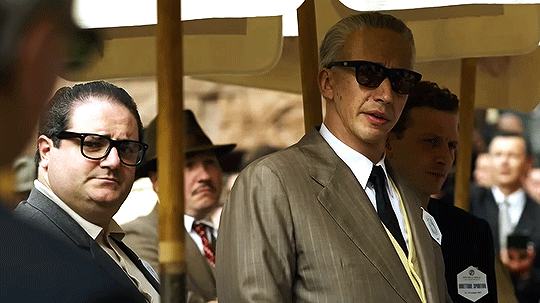
Boston Strangler (2022; d. Matt Ruskin)
I admired this film so much and put it in my “top” list for last year. In former times, i.e. better times #sorrynotsorry, a movie like this would have been in theatres for a month, a month and a half, and would have picked up steam through word of mouth, good reviews. More people would know about it. It wouldn’t be lost in the maw of “content” rotating across the main pages of streaming services. Ugh. It’s a really good story, Zodiac-like in its intensity and mystery, with a fascinating duo at the center, played by Carrie Coon and Keira Knightley. The true story of the “girl reporters” who worked the case. It’s terrific.

Never Let Me Go (2010; d. Mark Romanek)
I saw this in the theatres in its first release and haven’t seen it since. My memory of reading the book is pretty visceral. So DEPRESSING. With Ishiguro’s typical restraint: the restraint a way to contain/suppress the massive feeling, which you saw in his Remains of the Day too. I think the approach of the film is correct: it takes a while for the rules of this world to reveal itself, since the main POV is children, who’ve never known anything different.
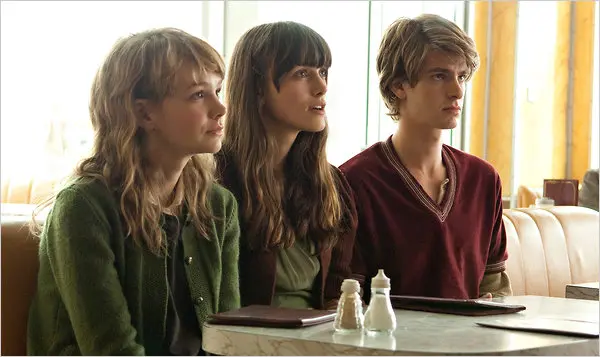
Seduced: Inside the NXIVM Cult (2020)
A re-watch. The Vow got all the press, all the attention. Believe me, I watched it and I think it does a great job, for what it’s trying to do. But Seduced is better, and also more important. The Vow focused on the upper echelon of people, the people involved in propping up this cult, justifying it to outsiders, keeping it running. I’m glad those people got out, saw the light. But their position was a lofty one. It’s the difference between Mike Rinder and a rank-and-file Sea Org member. One is elite, the other anonymous. Seduced is different. India Oxenberg got caught up in this thing, and her mother, Catherine, went public with her concerns, using her own celebrity to shine light on this cult and what it was doing. Seduced is about India and Catherine, both of whom are interviewed extensively. The big-wigs of The Vow are turned into minor characters. Seduced also brings in all kinds of cult and mind-control experts, to explain HOW this happened, and how high-control groups operate, and how vulnerable the brain is. This was the missing piece in The Vow. Seduced actually wants to help others. I think it does a very good job in using these experts to explain different events, to explain NLP and mind-control tactics, used by the leaders of this group, and how vulnerable peoples’ minds are. I admire India so much for her transparency in discussing these potentially very embarrassing subjects. She’s done a great service with this docuseries.
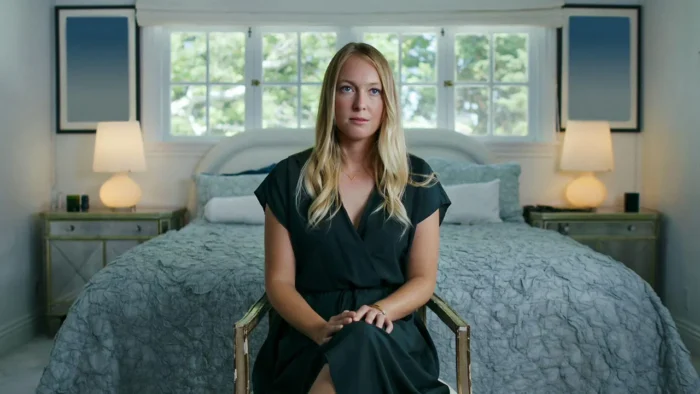
The Potemkinists (2021; d. Radu Jude)
In Jude’s amazing 2018 film I Do Not Care If We Go Down in History as Barbarians, he interrogates the history of Romania, but more so the myths and lies it tells to itself. This is his territory: it’s where his creativity lies, and it’s creativity spiced with humor, absurdism, surrealism, and insightful political satire: I mean, even beyond satire. He lamPOONS things. National narratives are erected to obscure or even invent a truth. National narratives are designed to control. These are dangerous Orwellian concepts. As Orwell laid out in 1984: Real power does not lie in controlling the present. Real power comes when you can control the PAST. Millions of lives are impacted directly by invented national truths. Jude goes after these truths. He explored this as well in 2022’s Bad Luck Banging or Loony Porn, in my Top 10 of that year, although Bad Luck Banging was more about Right Now (in fact, it’s one of the most Right Now films I’ve seen in the past 5, 6 years, where every filmmaker appears to be trying to comment on our current moment. Nobody nailed the absolute STUPIDITY of Right Now better than Jude in Bad Luck Banging.) In all Jude’s work, history looms alongside the present, but it’s not DEALT with in an honest way. Truth doesn’t just EXIST in and of itself. This makes sense considering Romania’s 20th-century history. Living for decades under the monstrous personality cult surrounding Nicolae Ceaușescu distorts reality. The past is destroyed, lied about. The present is obscure. There’s no valid way to get trustworthy information. The personality cult surrounding Ceaușescu rivaled and in some cases surpassed the personality cult of Stalin. So Jude, a very Right Now guy, attempts to piece together what the hell happened. The Potemkinists is a short film showing a sculptor (Alexandru Dabija) pitching a new sculpture idea to a government bureaucrat (Cristina Draghici). The bureaucrat is distinctly unimpressed. They climb up these concrete steps to a famous ridiculous statue overlooking one of those monstrous canals built during the Stalinist years (millions died building these fucking things). The statue was erected to honor Communist Youth or some such bullshit, and the sculptor wants to re-do it. He wants to reveal the truth behind Sergei Eisenstein’s Battleship Potemkin — which, famously, ends in solidarity, where all the warring Russians realize they are brothers and comrades and shouldn’t be shooting at each other. But the REAL story (which I was unaware of) was that these mutinous sailors found asylum in Romania. In 1905, this was a clear act of aggression against Russia, and a slice of forgotten history. The sculptor wants to re-make the monument to Communist bullshit to honor the sailors – AND Romania – for its act of rebellion. The bureaucrat is distinctly NOT into it. The film is 18 minutes long and is spliced together with shots from Battleship Potemkin. I point you to J. Hoberman’s excellent essay in Art Forum about the film. It’s streaming on Amazon!
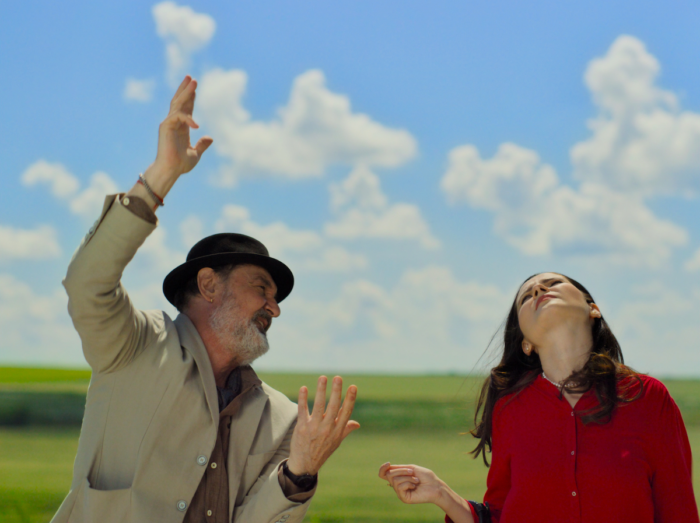
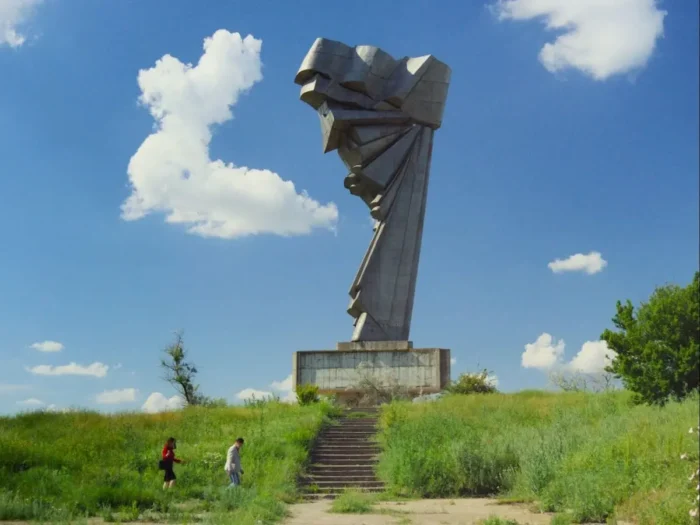
Thank you so much for stopping by. If you like what I do, and if you feel inclined to support my work, here’s a link to my Venmo account. And I’ve launched a Substack, Sheila Variations 2.0, if you’d like to subscribe.

Photo: David Lei, via Associated Press
New Yorkers are in mourning for Flaco, the Eurasian eagle-owl, who has been living his best life in the Upper West Side ever since being “freed” from the zoo by some probably well-meaning vandal who slashed his cage. The Flaco sightings have been an amazing bonding experience for the city. He was spotted here, there, people posting pics, people gathering around, keeping a safe distance, but marveling at his beauty, his ferocious eyes, his glamorous appearance. There was a lot of concern, of course, about how he would fare out in the wild. I mean, he IS an apex predator, so you assume he knows his way around, but still: he’s been in a zoo. And now he has to navigate Manhattan. He was seen on various nocturnal murder sprees, surrounded by the carnage of his hunts, and people relaxed. He knew what to do. He’s got this. A number of the Twitter feeds I follow are bird-watching accounts – they’re lovely and soothing, and the “Here’s Flaco!” posts were always exciting. People would post: “I SAW FLACO TODAY” and post some amazing picture of his fierce terrifying face peering out from a tree in Central Park.
Flaco, a King of the Sky, flew into a building last night. There’s something very emotional to see so many people mourning an owl, having room in their hearts to mourn his passing, to celebrate his life. A beautiful owl who would show up on people’s terraces randomly, sometimes even peeking through their windows!! – or be seen perched in a tree in the park, or on top of a water tower, during his year of freedom. And people would post pics to social media, and the comments would all be about how beautiful he was, and New Yorkers hoping they could see him and people from Egypt and Moscow and wherever else chiming in about how gorgeous he was and how jealous they were, they wanted to see him too. Life – and people – are sometimes like this.
The NY Times obituary for Flaco is unexpectedly moving. Like this:
One poignant aspect of Flaco’s Manhattan life was that, as a nonnative species, he was destined never to find a mate. That did not stop him from trying, sometimes hooting into the post-midnight darkness for hours to establish his territory and declare his interest in breeding.
Flaco’s last reported hoots were heard from a water tower on West 86th Street east of Columbus Avenue at 3 a.m. last Sunday, according to David Barrett’s Manhattan Bird Alert account on social media.
Rest in peace, Flaco. You were a blessing.

Mitchell

Sandi

Me
As always, there must be a backstory.
There was an old rickety amusement park in our state – similar to Adventureland, if you know the movie – where you took your life into your hands on the rides, and pretty much everyone who lived in the state worked there at least at some point. Like, my friend Betsy worked the cotton candy counter one summer. I mean, this is just one example of many. Cut to: college. My friend Mitchell actually auditioned for the amusement park’s “entertainment” – actually I think I did too. Maybe we all did? No idea. The point is: Mitchell actually got cast. It was a big deal! He was cast as some douchebag called Doc Abbott, who stood on a little platform and made bad jokes, pulling out fake floppy fishes and shit like that. Low-rent Borscht Belt shit. So Mitchell is there at his first day of rehearsal with all the other cast members – dancers, “comedians”, whatever. And there was all this group stuff they had to do, besides their specialty acts. Meanwhile, Mitchell is mortified at the Doc Abbott script he’d been given. Like, it’s horrible stuff. Not even sitcom level. It’s like “take my wife, please” but not EVEN! He’s already thinking, “How the hell am I gonna get out of this.” As he is thinking this, a hot Rhode Island girl (it’s a type, think Mercedes Ruehl in Fisher King), wearing spandex tights, a bandeau, and leg warmers, was complaining about having to do all this OTHER stuff – skits etc. – and she whined, thick Rhode Island accent, “Allz I wanna do is dee-yance.” This was Mitchell’s breaking point. He didn’t return to rehearsal the next day. I think he basically just never showed up again. lol
But because Rhode Island is what it is, we would go there all the time, still, in the summer, to fuck around and buy underage beer and go on the flume. The whole Doc Abbott thing made it a little precarious: like, would they all be mad at him? (Of course they were!) Should we HIDE from management? Should we duck and run if we saw someone with a badge? It’s not like we were banned from the park but it was potentially awkward! I mean, he just never showed up after the first rehearsal! But to NOT go to the amusement park was NOT an option.
So one day, Mitchell, Mitchell’s sister Sandi and I went. It was a hot day. We drank beer. Nobody was 21. We went on the flume and got soaking wet. We had a ball. We were also basically hiding from any amusement park employees who might notice that the Doc Abbott deserter was strolling around in the park.
Then we saw it. The Doc Abbott stage where Mitchell was supposed to spend his summer barking out terrible jokes to an irritated drunk crowd. And so we did the only thing we COULD do.
Way to fly under the radar, kids.
It’s his birthday today.
I so respect his work in Hidden Figures, where he plays “support staff” to Taraji Henson.
Some thoughts on actors’ understanding of storytelling functions and how they fit into stories:
Actors are storytellers, and they understand FUNCTION more than regular civilian type people understand it.
When Harrison Ford came and spoke at my school, he answered each question about any given role in terms of story. He understood his FUNCTION in Star Wars, he understood his FUNCTION in Working Girl. Two totally different functions. Know what movie you’re in. In the DVD extras for ’42, Harrison Ford spoke all about function, how his character fit into the story, and how far he wanted to go with his characterization, in order to highlight the real purpose of the story – which was Jackie Robinson. There’s a lack of ego in this kind of work. If you’re the star – like in Air Force One – you will bring your A-List Star Power to bear, because that role’s function requires it. But in Working Girl, he was second-banana to Melanie Griffith. In essence, he played the stereotypical “feminine” role. He knew that and embraced it (even down to the scene where he strips down in his office and all the secretaries ogle.)
I’m fascinated by Ali’s understanding of function.
Hidden Figures came out the same year as Moonlight. In Moonlight, in his Oscar-winning role, he also played “support staff,” but it required different things from him than in Hidden Figures. He’s so central to Moonlight it’s almost a lead role.
In Hidden Figures, he plays a romantic figure, a potential mate for Taraji Henson. There’s complexity in the role. He goofs up in their first interaction. He doesn’t know how to deal with a mathematician woman. He’s never even heard of such a thing. His sexism comes out. It’s beyond his control. (Ali does this so well. He does it in a way that lets you know that this is not a bad man. This is a man of his time, as we all are people of our own time.)
In his next interaction with her, at a party, he tries to let her know that he is interested, but also, without saying anything, that he feels bad about their first interaction. He knows he messed up. She, though, a widow with two children, and a stressful competitive job in a mostly white profession, is not easily romanced or wooed. She’s not dating around. She’s a serious woman.
They dance. He fumbles around with an explanation for his earlier goof. In this interaction, you see that he is not a smoothie, even though he’s catnip for the ladies in his military uniform. He’s not a sweet talker. He’s a good man, who is interested in this woman, but he needs to backtrack around his own fumbled comments to try to get her to trust him, to let him in. He has to own himself, in other words, he has to own his own limitations, he has to own what he said to her so they can move on. It’s not all on her to read his mind and work it out like “Oh, he didn’t mean it, this is just how men are, I’m used to it, I’ll give him another chance.” She makes him work a little bit. I’m old-fashioned. This is how it should be. And it goes both ways. We all need to “prove” that we’re worthy. We need to show up as our best selves. This is especially true once we have more miles on us, and we’ve been hurt, disappointed. She’s a woman of experience and she doesn’t have TIME for a guy who’s not serious, who’s not looking to settle down. She has children.
There are so many layers to what’s going on in this one scene when they dance at the party. He makes her laugh, and she finally says, but with more warmth now, he’s done the job of showing his worth, he’s halfway there: “I still haven’t heard an apology” and he “mans up” (as they say) and apologizes. It’s required. He knows he messed up and he knows she is worth it. Ali plays ALL of this in a scene 5 or 6 minutes long. Actors, watch and learn!
When he finally proposes to her, in front of her daughters and her mother, I become an absolute WRECK, and I’ve seen the movie 10 times by now.
It’s a beautiful and deep performance. He cedes the floor to her. Because that’s his function in the story. This story isn’t about him. It’s about HER, and how he fits into HER narrative.
Some actors have a hard time with this. They want to add dark twisty complexity to a role so they feel like they’re DOING something. It’s not ENOUGH to be a romantic lead, to highlight the desirability of the woman, to be a secondary figure in a drama about women. It’s “triggering” for some male actors.
When the Hidden Figures‘ end credits roll and you read that the real-life couple recently celebrated their 57th wedding anniversary or some insane number like that, you completely believe it, based on the relationship created between the two actors (in not a lot of scenes, I might add. And they only kiss once. It doesn’t matter.)
One last thing: I first clocked him in the movie Kicks – where he only has one scene – and I remember thinking: “Who the HELL. is THAT.” I wrote about it in my review.
He’s so believable I thought he couldn’t be an actor. I thought they must have just “found” this real guy and put him in the movie.
These roles are all so different I am convinced Mahershala Ali can do anything. He can fit into any story. Because he understands function.
UPDATE: I finally caught up with True Detective (I know, I know, I am always years late). I skipped Season 2, on the advice of my friends who are fans, and dove into Season 3. I find Ali’s work absolutely astonishing. He plays three different ages. He is believable at each age. The old man is the result of the young man’s experience. You can see it in his face. His portrayal of old ago is completely authentic. It is a very complicated character and not always likable or relatable. His relationship with his wife was thorny and often strange: deep waters being stirred. A very troubled man, taciturn, gifted, dogged, rigid. Heartbreaking. A major performance.
Thank you so much for stopping by. If you like what I do, and if you feel inclined to support my work, here’s a link to my Venmo account. And I’ve launched a Substack, Sheila Variations 2.0, if you’d like to subscribe.

I reviewed Players for Ebert. Honestly, it doesn’t really work overall, but the group dynamic is often very funny – and there’s one line by a guy who shows up once – “Uh, I’m a librarian” – that made me laugh out loud. I give points for that!

On my Substack I wrote about three television events which aired in the jittery world of 1983-84, all of which depict the aftermath of a nuclear bomb: the BBC’s Threads, aired only twice, scarring a generation, the American version, The Day After, and the less well-known (but much better) Special Bulletin.
Sticks and Stones: Nuclear winter chic in the early ’80s: Threads, The Day After, Special Bulletin

This movie is so quiet and beautiful, very intriguing style and approach. I did my best to describe how it worked on me. Highly recommended. I reviewed for Ebert.